Sleep Statistics By Dreams, Country, Problems, Bedtime Worries, Demographics and Medications
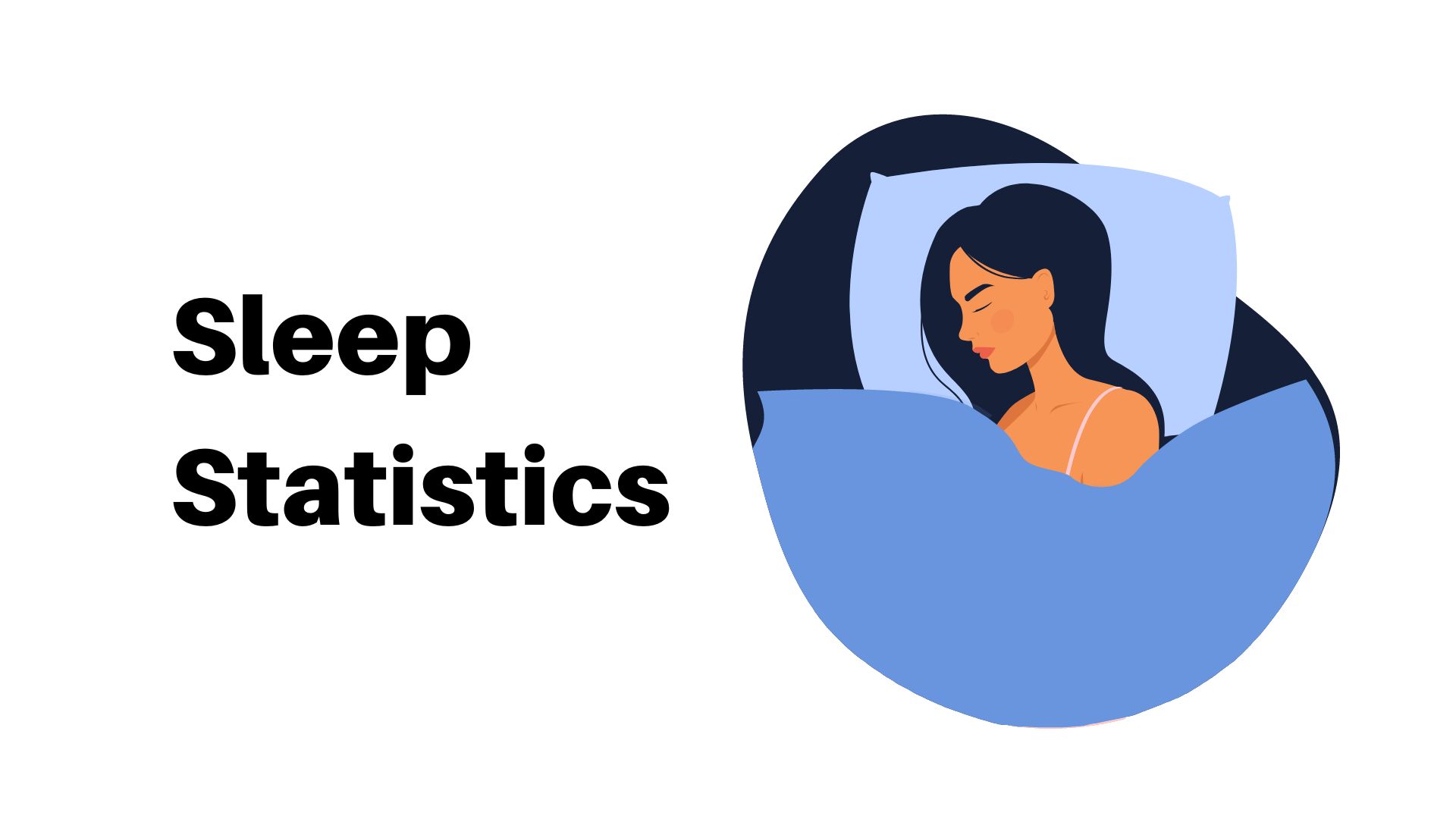
Page Contents
- Introduction
- Editor’s Choice
- Benefits of Sound Sleep
- General Sleep Statistics
- Sleep Statistics By Dreams
- Sleep Statistics By Average Sleep Required
- Sleep Statistics By Bedtime Worries
- Statistics By Problems
- Statistics by Country
- What Would Americans Sacrifice For a Month of Perfect Sleep?
- Sleep Statistics by Region
- Sleep Statistics By Positions
- Sleep Statistics by Demographics
- Sleep Statistics By Medications
- Sleep Statistics By Bedtime Habits
- Sleep Statistics By Impacts
- Sleep Statistics By Quality Sleep
- Sleep Statistics By People Who Snore
- Sleep Statistics By Sleep Duration
- Sleep Statistics By College Students
- Sleep Statistics By Sleep Aids
- Conclusion
Introduction
Sleep Statistics: Sleep is the most important factor in an individual’s life. Sleep provides calmness and improves focus toward goals. Today, people are so engaged in their schedules that they fail to follow regular sleep cycles, causing other side effects on health. As an adult, it is a must to sleep at least 7 to 8 hours every night.
These Sleep Statistics are written with recent insights focusing on the United States of America. We have also added one segment of sleep time rituals that people do which is extremely interesting to read.
Editor’s Choice
- People who regularly follow sleep cycles are 1.5 times more likely to feel energetic and well-rested during the day.
- Because of sleep deprivation, every year 100,000 deaths occur in US hospitals through medical errors.
- If Americans increase their sleeping time to 7 hours collectively, they will add $226.4 billion to the United States of America’s economy.
- According to Sleep Statistics, women are more likely to face trouble falling asleep than men resulting in 26% to 16% once a week.
- There are 19% of people use marihuana, which helps them to reduce pain-related sleep issues.
- The loss reported due to sleep deprivation in the United States of America is $411 billion a year.
- Men are more likely to dream about other men while women dream about men as well as women.
- Sleep Statistics state that additional 60 to 90 minutes of sleep every night make the person healthy and happy.
- 50% of dreams get vanished from the memory in the first 5 minutes of waking up.
- 1 out of 10 Americans keep sleep as a top priority over hobbies, social life, fitness, and work.
Benefits of Sound Sleep
- A good night’s sleep improves brain functions.
- Provides energy to the body.
- Refreshes your mind.
- Keeps your heart healthy.
- Improves digestion problems.
- Keeps your mind alert.
- Balances hormone levels in the body.
- Reduces stress level.
- Reduces probable skin allergies.
- Helps to lose weight.
- Strengthens the immune system.
- A complete sleep around a week creates a positive aura.
General Sleep Statistics
- Around 50% of Americans have a regular sleeping partner.
- 40% of Americans wash their sheets each week, while 32% of the sheets are washed every 2 weeks.
- Furthermore, 51% of the people wash their pillows every 3 months.
- 1 out of 10 Americans keep sleep as a top priority over hobbies, social life, fitness, and work.
- 5% of Americans get less than 7 hours of sleep.
- Moreover, 68% of the people in America struggle to sleep at least one day a week.
- On average, an individual needs 7 minutes to fall asleep.
- Sleep Statistics state that additional 60 to 90 minutes of sleep every night make the person healthy and happy.
- People who regularly follow sleep cycles are 1.5 times more likely to feel energetic and well-rested during the day.
- People with a schedule of 5 to 6 hours of sleep are more likely to fall sick than people who get 7 hours of sleep every day.
- 48% of Americans snore every day.
- People with sleep cycles of less than 7 hours became excessive alcohol drinkers (19%), physically inactive (27%), overweight (33%), and smokers (23%).
- 40% of Americans are always in need of sleep.
- The loss reported due to sleep deprivation in the United States of America is $411 billion a year.
- People with irregular sleeping habits are 12% more likely to die ahead of time.
- If Americans increase their sleeping time to 7 hours collectively, they will add $226.4 billion to the United States of America’s economy.
- Because of sleep deprivation, every year 100,000 deaths occur in US hospitals through medical errors.
- 90% of sleep paralysis cases involve moments of fear.
- 6% of people live in households with people that struggle with a sleep disorder.
- 7% of people say that sleep problems run in the family.
- 2% of people are short-sleepers.
- On the other hand, 88.6% of people have sleep disorders.
- The average time of sleep is decreased by 27 minutes every decade as per Sleep Statistics.
- Women are more likely to sleep a few minutes extra than men.
- The average dose of melatonin consumed by an American is 4.8 mg for reducing sleep problems.
- In the United Kingdom, 1 out of 4 couples sleep on separate beds.
- Sleep Statistics state that the sleeping positions and personality of that person have a direct connection.
- 49% of Americans sleep on pillow top matters or innerspring.
Sleep Statistics By Dreams
- 50% of dreams get vanished from the memory in the first 5 minutes of waking up.
- 65% of dreams are full of anger and sadness while 20% of them are filled with excitement and happiness.
- Men are more likely to dream about other men while women dream about men as well as women.
- Nightmares are reported by 80% of people with PTSD.
Sleep Statistics By Average Sleep Required

(Source: purple.com)
- According to Sleep statistics of recommended sleep times for different aged people, newborns aged between 0 to 3 months require 14 to 17 hours of sleep.
- Infants aged between 4 months to 11 months require 12 to 15 hours of sound sleep every day.
- On the other Toddlers aged between 1 to 2 years and 3 to 5 years respectively need 11 to 14 hours and 10 to 13 hours of undisturbed sleep.
- Kids aged 6 to 13 years need 9 to 11 hours of sound sleep.
- Moreover, adolescents between 14 to 17 years need 8 to 10 hours of sleep.
- And group adults aged 18 to 65 years and above require 7 to 9 hours of sleep every day.
Sleep Statistics By Bedtime Worries
- As of 2022, Sleep Statistics in the United States of America state that the majority of people worry about certain things during bedtime.
- 22% of the people think about the Russia-Ukraine war during sleep, similarly, 22% of the people worry about climate change.
- Whereas 27% of Americans stated that they worry about gun violence in the USA, while 39% worry about COVID-19 during sleep hours.
- And 41% of Americans keep thinking about inflation.
Statistics By Problems
- 46% of the people state that they have a snoring partner that creates problems to sound sleep.
- On the other hand, 32% of Americans said their partner takes over the bedding.
- Whereas 29% of the people stay awake because of their sleeping partner’s movements.
Statistics by Country
The Popularity of the Sleep Monitoring Apps
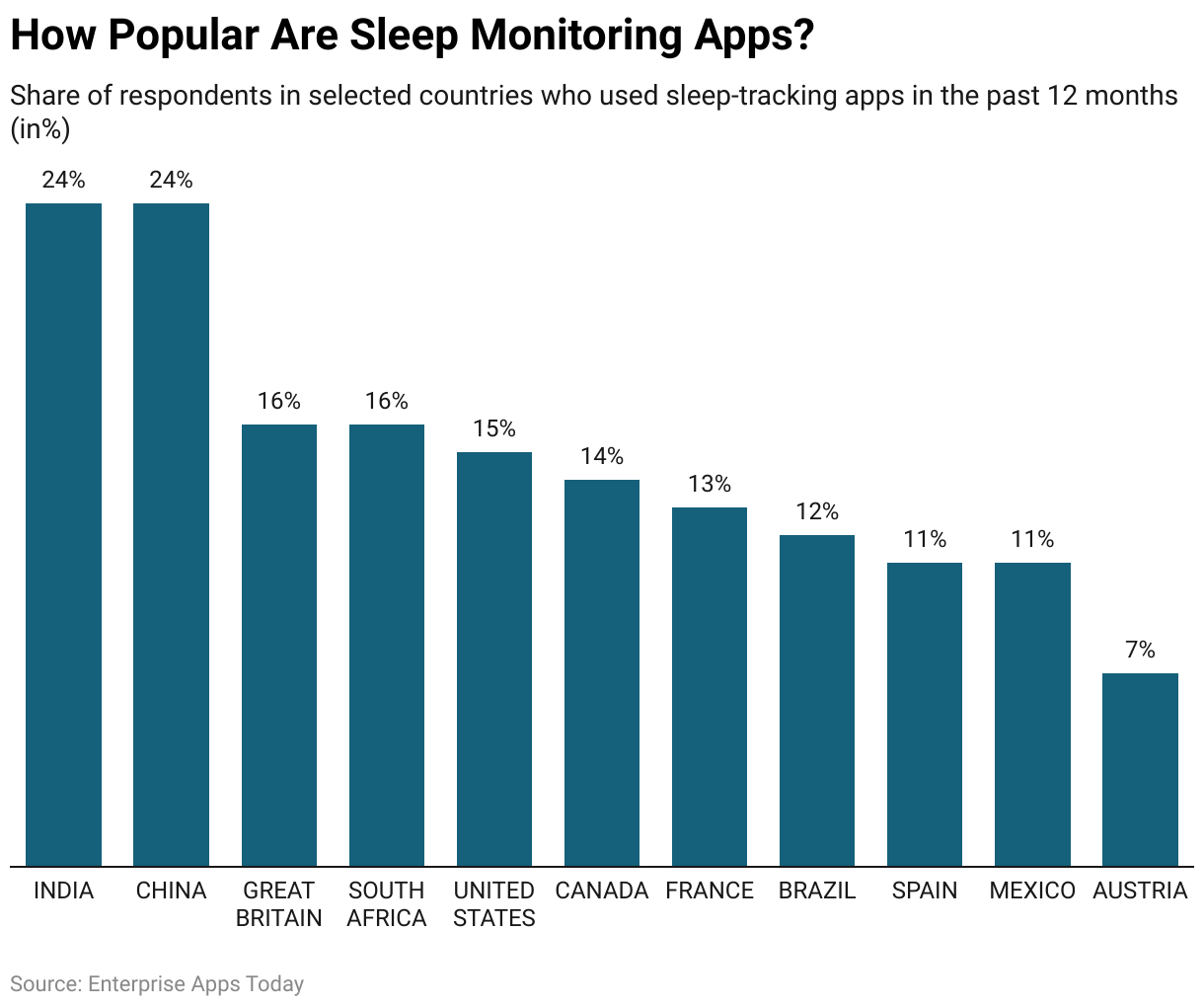
(Reference: Statista.com)
What Would Americans Sacrifice For a Month of Perfect Sleep?
- 18% are ready to give up their cell phones, while 25% of Americans are ready to give up music for one month.
- There are 27% of Americans are willing to give up on TV/movies for 30 days.
- 28% of the people are ready to stay away from seeing their friends.
- And 38% of Americans are willing to give up eating out for one month in exchange for perfect sleep.
Sleep Statistics by Region
By People Who Snored
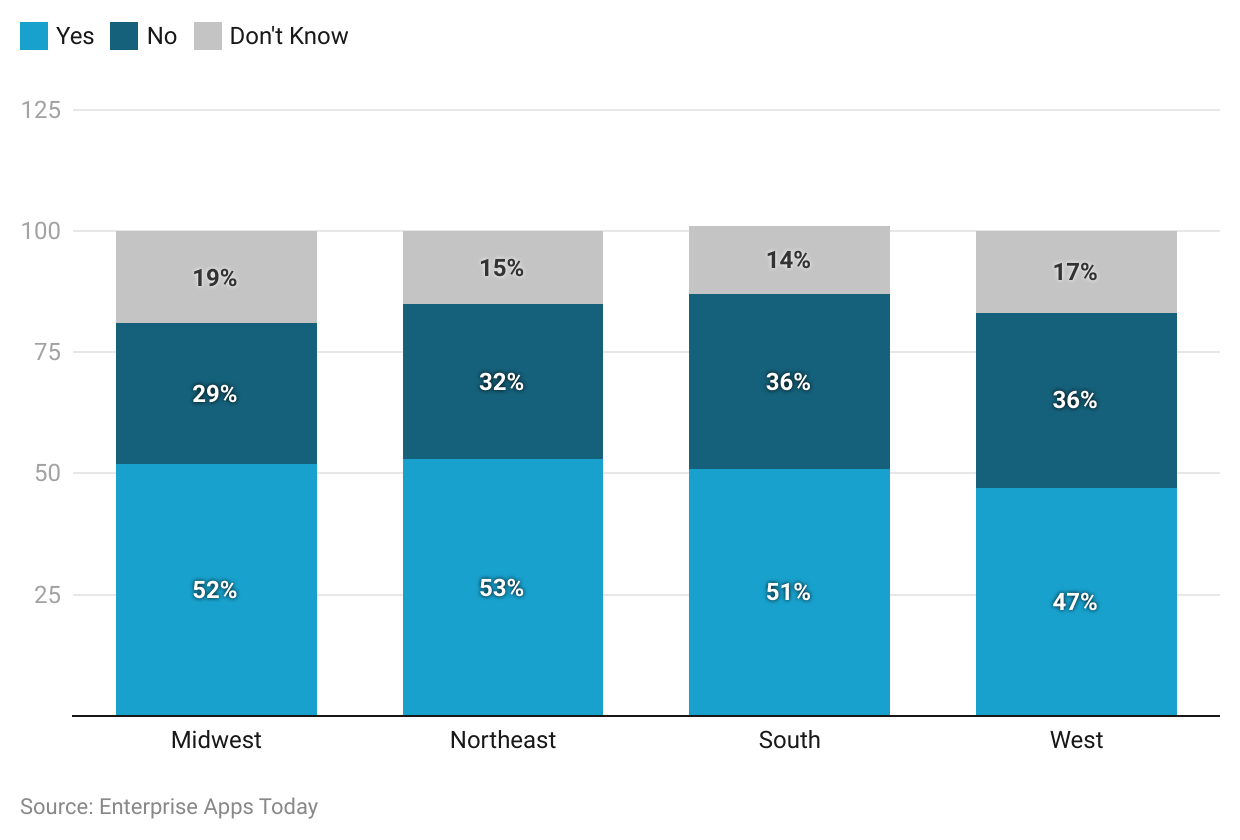
(Reference: Statista.com)
- As of 2022, in the United States of America, people living in various areas who stated their snoring habits, are mentioned as follows.
- Midwest: People that snore (52%), People that don’t snore (29%), and People who don’t know (19%).
- Northeast: People that snore (53%), People that don’t snore (32%), and People who don’t know (15%).
- South: People that snore (51%), People that don’t snore (36%), and People who don’t know (14%).
- West: People that snore (47%), People that don’t snore (36%), and People who don’t know (17%).
Sleep Statistics By Positions
- 41% of the people mostly sleep in the fetal sleeping position.
- While 28% of Americans are side sleepers.
- 8% of them prefer to sleep in the back position and 7% of the people sleep on their stomachs.

(Source: casper.com)
Sleep Statistics by Demographics
- According to Sleep Statistics, women are more likely to face trouble falling asleep than men resulting in 26% to 16% once a week.
- As of 2022, healthy sleep habits are followed by mixed non-Hispanic and black non-Hispanic (54%), Asians (63%), Hispanics (66%), and non-Hispanic white (67%).
- A child can cause a mother to sleep insufficiently by 46%.
- People aged 65 years and above are more likely to suffer from obstructive sleep apnea.
- 60% of young adults aged between 18 to 29 years add sleep cycles to their schedules.
By Trouble Falling Asleep
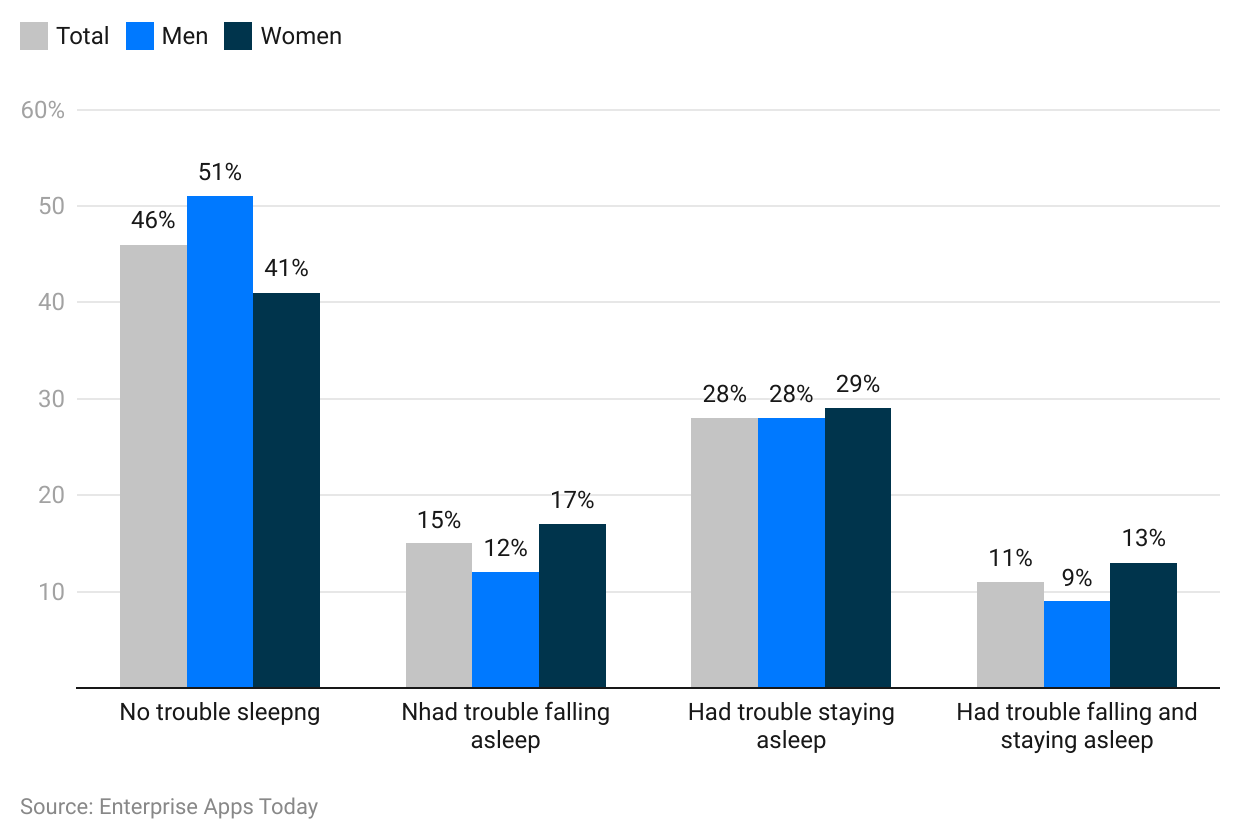
(Reference: Statista.com)
Sleep Statistics By Medications
- As of 2022, in the United States of America, people with sleep problems take the help of medications. According to Sleep Statistics, 20% of people do meditation to improve sleep.
- 20% of Americans take natural supplements such as valerian root or melatonin to improve sleep quality.
- Moreover, there are 19% of people use marihuana, which helps them to reduce pain-related sleep issues.
- 12% of the people in America regularly consume prescription sleeping pills.
- And 11% of Americans take CBD.
- Sleep apnea is more common in men than women compared to 21% to 9%.
Sleep Statistics By Bedtime Habits
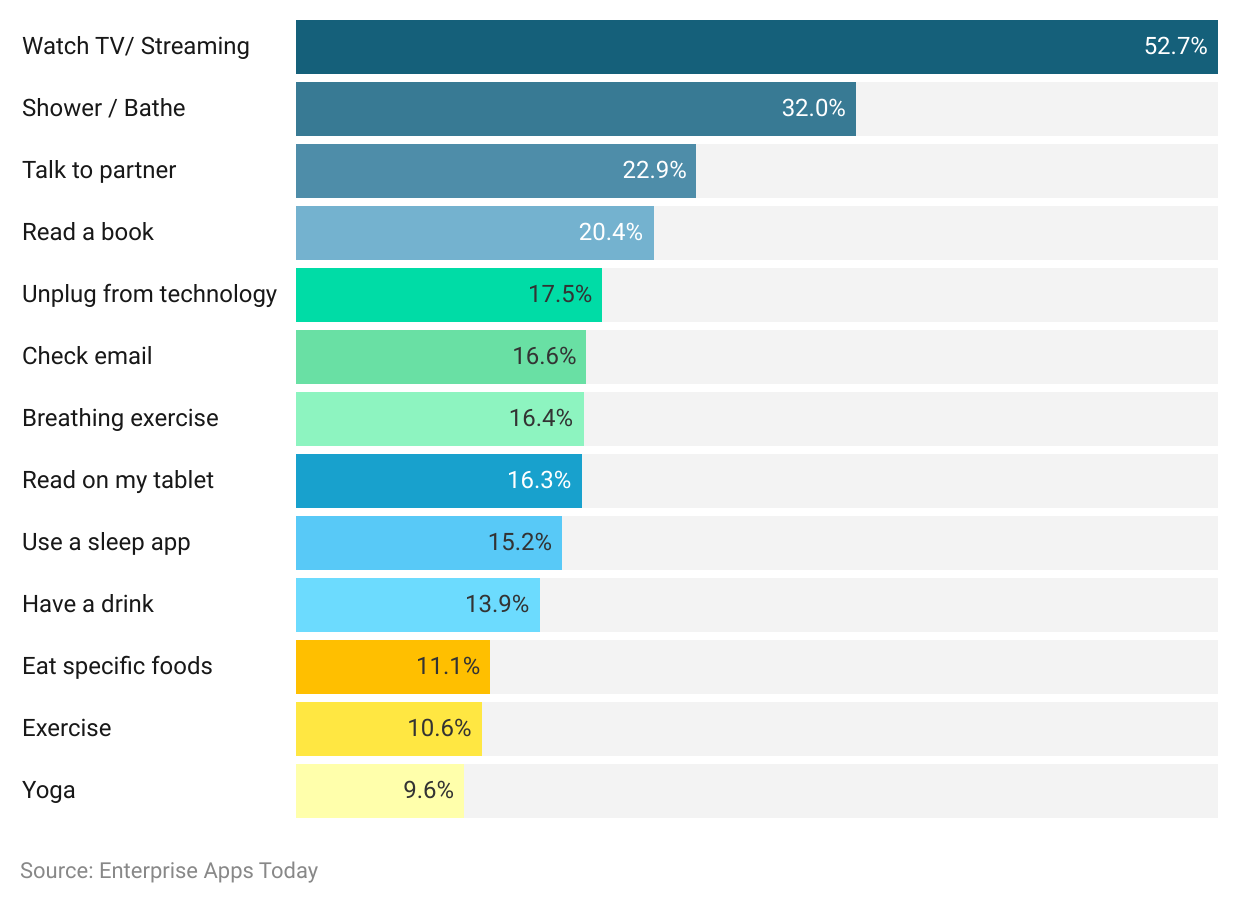
(Reference: sleepfoundation.org)
- As of June 2022, rather than sleeping, many Americans do random things which elevate their mood.
- The majority of people watch TV or other streaming platforms during sleep time resulting in 52.7%.
- Other sleeping time habits include taking a shower or bather (32%), talking to a partner (22.9%), reading a book (20.4%), or just keeping away all the digital material (17.5%).
- Further sleep time rituals stated by Americans are checking email (16.6%), breathing exercises (16.4%), reading on their tablet (16.3%), using a sleep app (15.2%), having a drink (13.9%), eating specific food (11.1%), exercise (10.6%) and doing Yoga (9.6%).
Sleep Statistics By Impacts
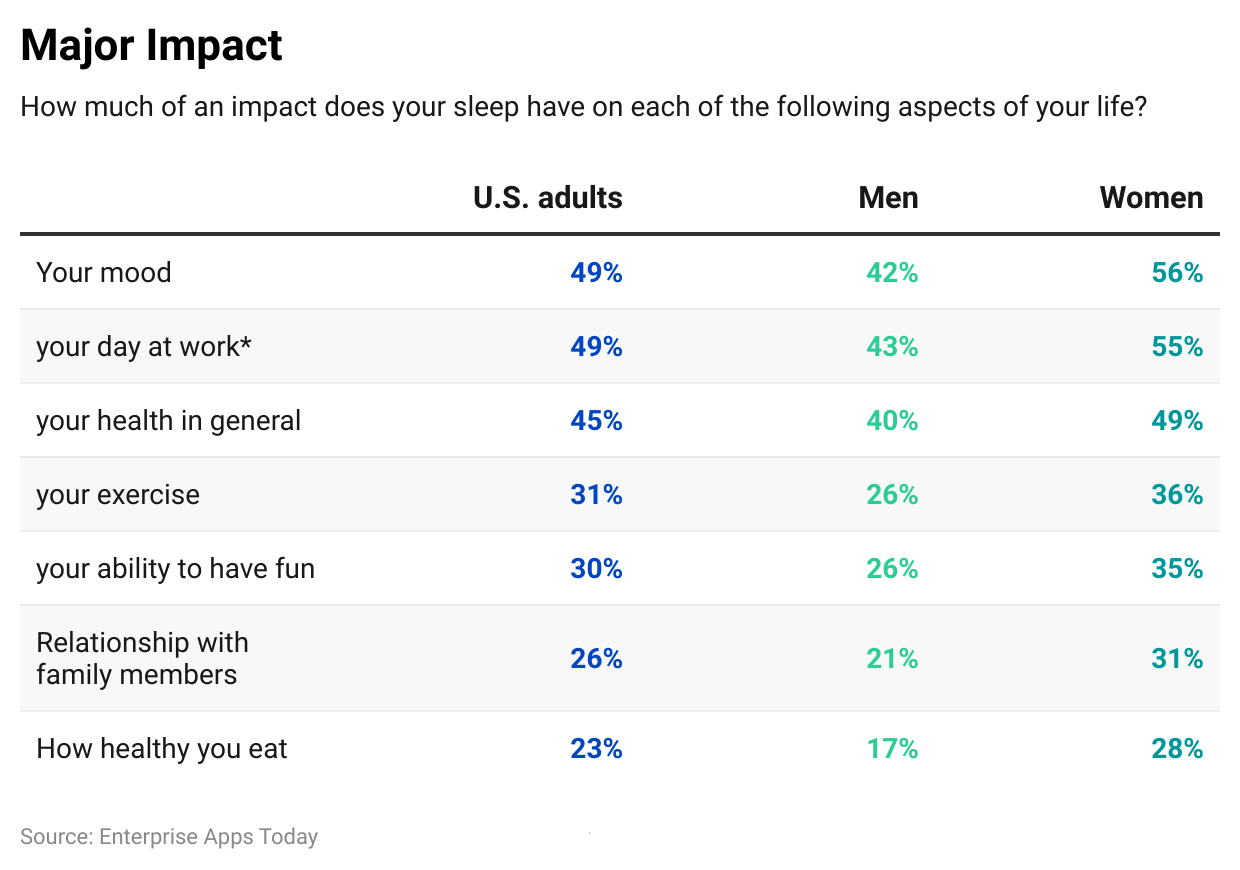
(Reference: gallup.com)
Above Good night Sleep Statistics state the obvious good effects on various factors in daily life. A large number of men and women agree that sound sleep elevates the mood 24 hours of the day resulting in 42% and 56%. Other mentioned factors are increased ability to have fun, improvement in general health and much more…
Sleep Statistics By Quality Sleep
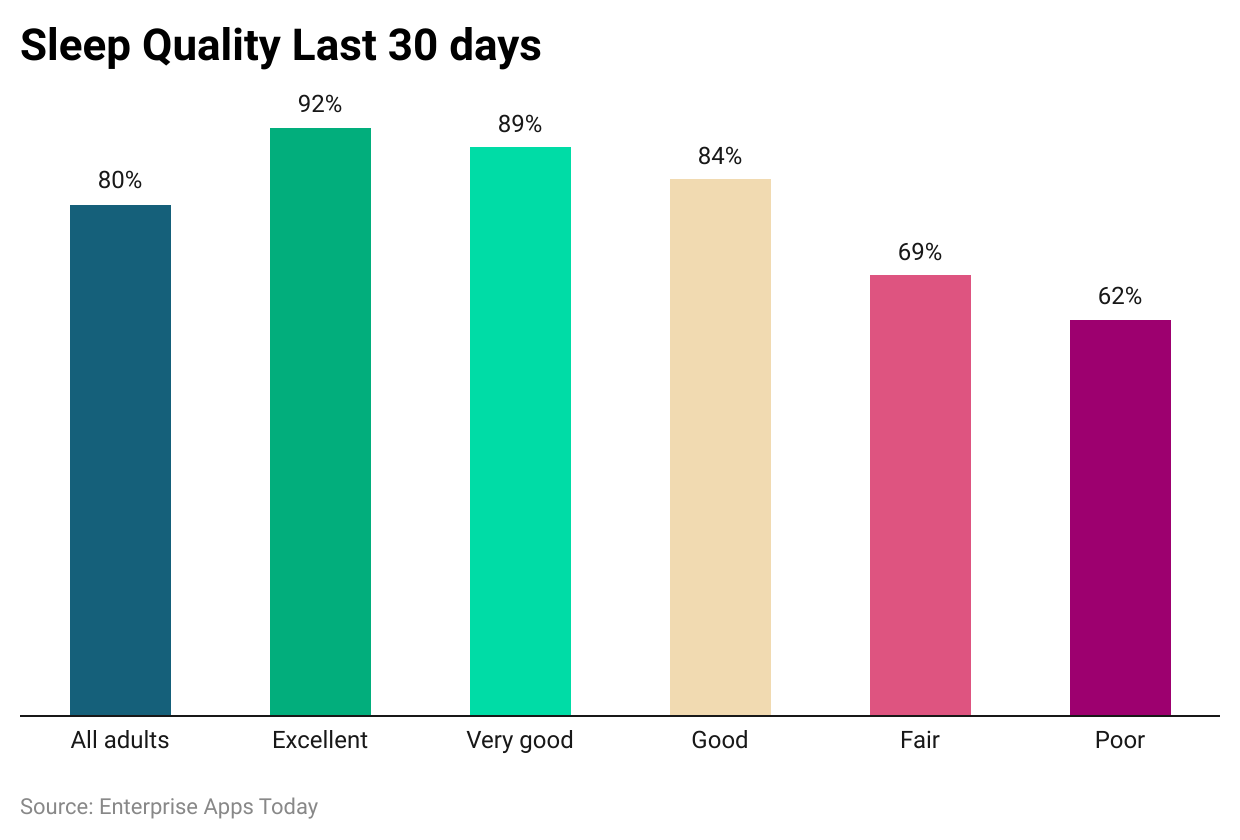
(Reference: gallup.com)
- Sleep Statistics of 2022 state that out of 92% of the adults in the United States of America, experienced excellent sleep over the last 30 days.
- 89% of the adults enjoyed a very good sleep while 84% reported having a good sleep in the past 1 month.
- 69% and 62% of adults in the USA had fair and poor sleep over the last 30 days.
By People Worry About Their Ability to Fall Asleep
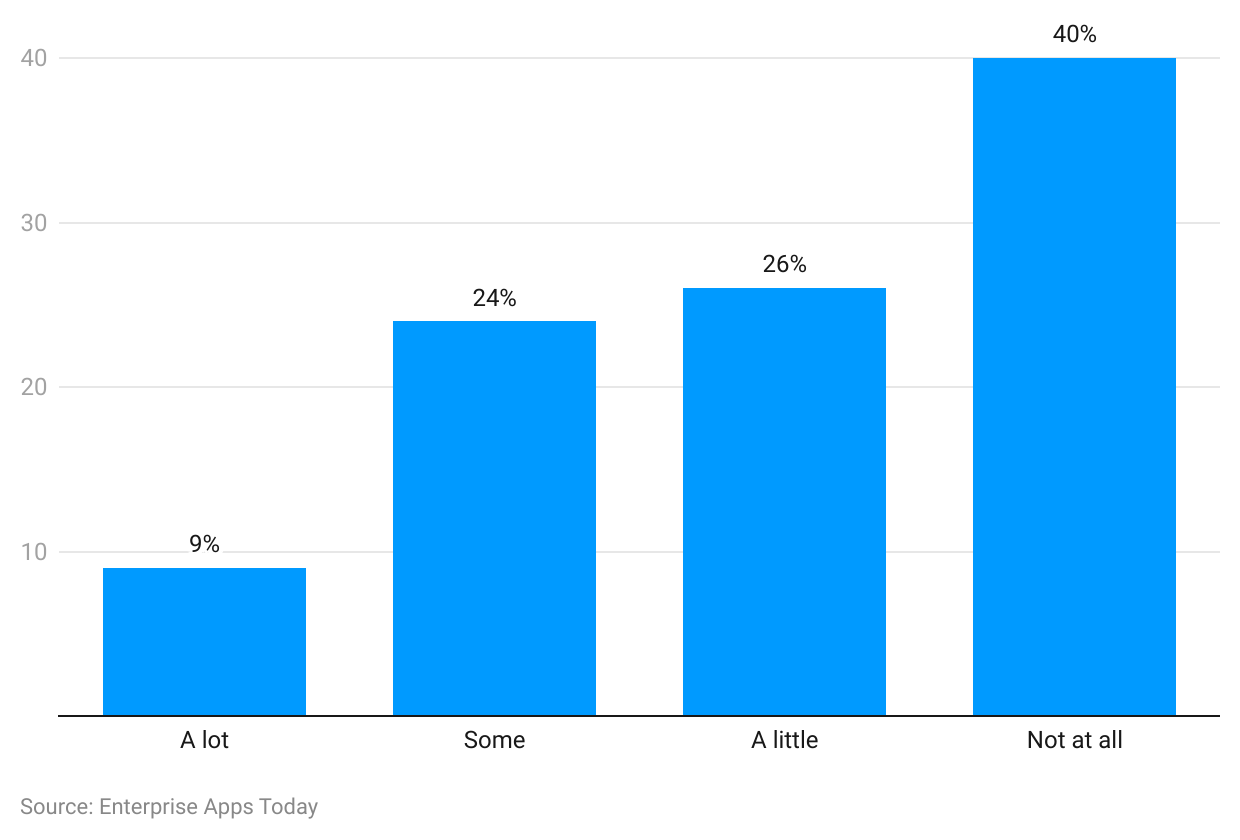
(Reference: Statista.com)
- In the United States of America, as of 2022, 9% of Americans are worried a lot about their ability to fall asleep.
- On the other hand, 24% of the people are somewhat worried while 26% are a little worried about their ability to sleep every night.
- The majority of the people in the United States of America resulting in 40% are not at all worried.
Sleep Statistics By People Who Snore
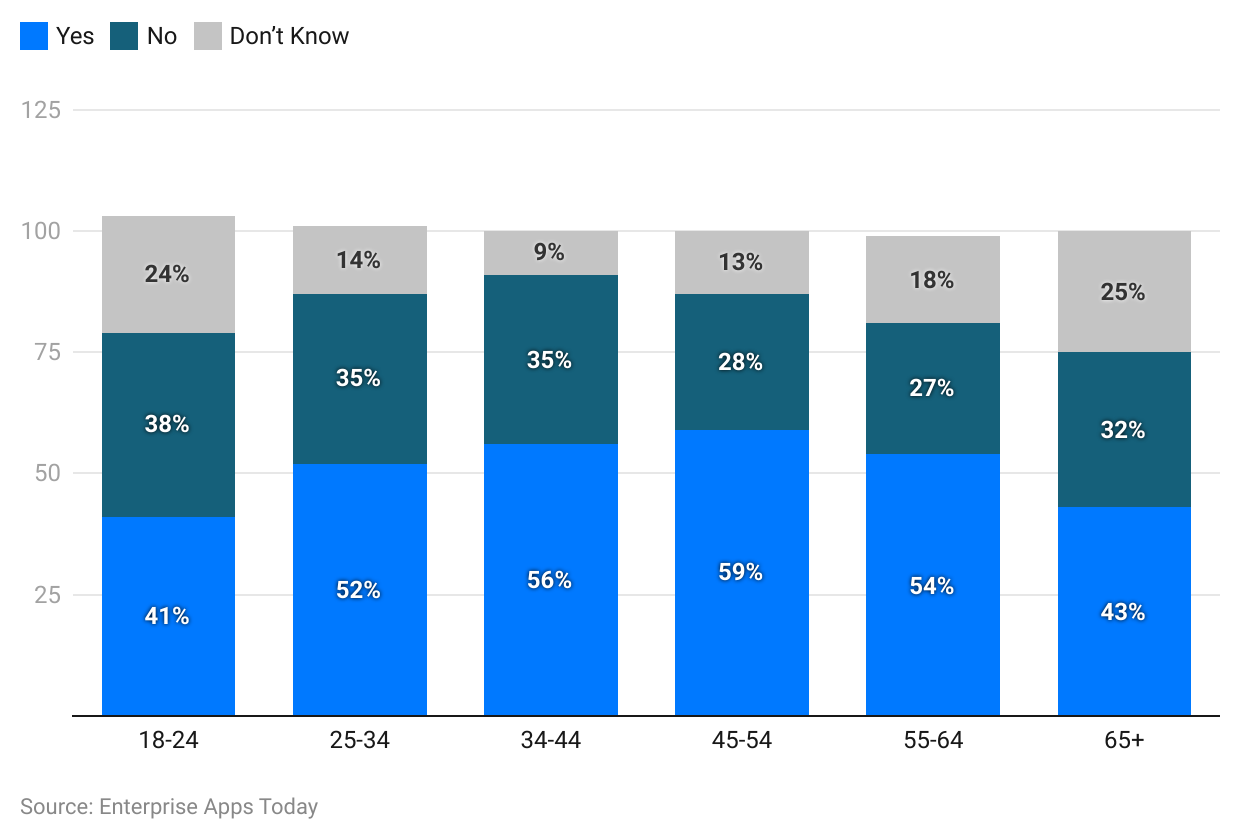
(Reference: Statista.com)
- Further Sleep Statistics of the United States of America in 2022 state the percentage of people who snore during the night as follows;
- 18 to 24 years – Adults who snore (41%), Adults who don’t snore (38%), and Adults who don’t know about it (21%).
- 25 to 34 years – Adults who snore (52%), Adults who don’t snore (35%), and Adults who don’t know about it (14%).
- 34 to 44 years – Adults who snore (56%), Adults who don’t snore (35%), and Adults who don’t know about it (9%).
- 45 to 54 years – Adults who snore (59%), Adults who don’t snore (28%), and Adults who don’t know about it (13%).
- 55 to 64 years – Adults who snore (54%), Adults who don’t snore (27%), and Adults who don’t know about it (18%).
- 65 years and above – Adults who snore (43%), Adults who don’t snore (32%), and Adults who don’t know about it (25%).
Sleep Statistics By Sleep Duration
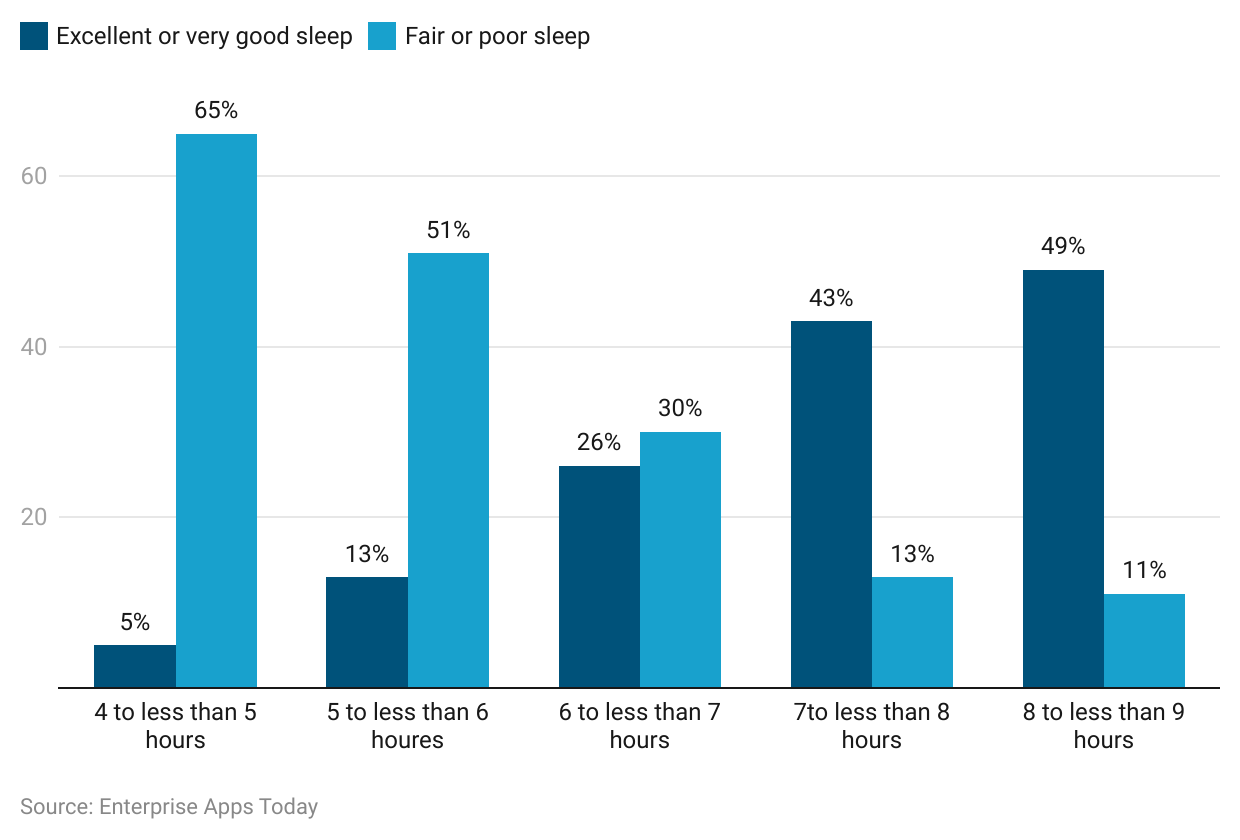
(Reference: Statista.com)
- Moreover, the following Sleep Statistics state the sleep quality in the past month in adults in the United States of America in 2022.
4 to less than 5 hours
- Excellent or very good sleep (5%)
- Fair or poor sleep (65%)
5 to less than 6 hours
- Excellent or very good sleep (13%)
- Fair or poor sleep (51%)
6 to less than 7 hours
- Excellent or very good sleep (26%)
- Fair or poor sleep (30%)
7 to less than 8 hours
- Excellent or very good sleep (43%)
- Fair or poor sleep (13%)
8 to less than 9 hours
- Excellent or very good sleep (49%)
- Fair or poor sleep (11%)
Sleep Statistics By College Students
- In the United States of America, Sleep Statistics state that 73% of high school students don’t get good sleep.
- Whereas 36% of University students are more likely to sleep less than 7 hours every night.
- Moreover, around 10% of undergraduate students get enough sleep of 7 hours.
- 68% of college students state that academic stress and personal issues are the reasons for failing to sleep at night.
Sleep Statistics By Sleep Aids
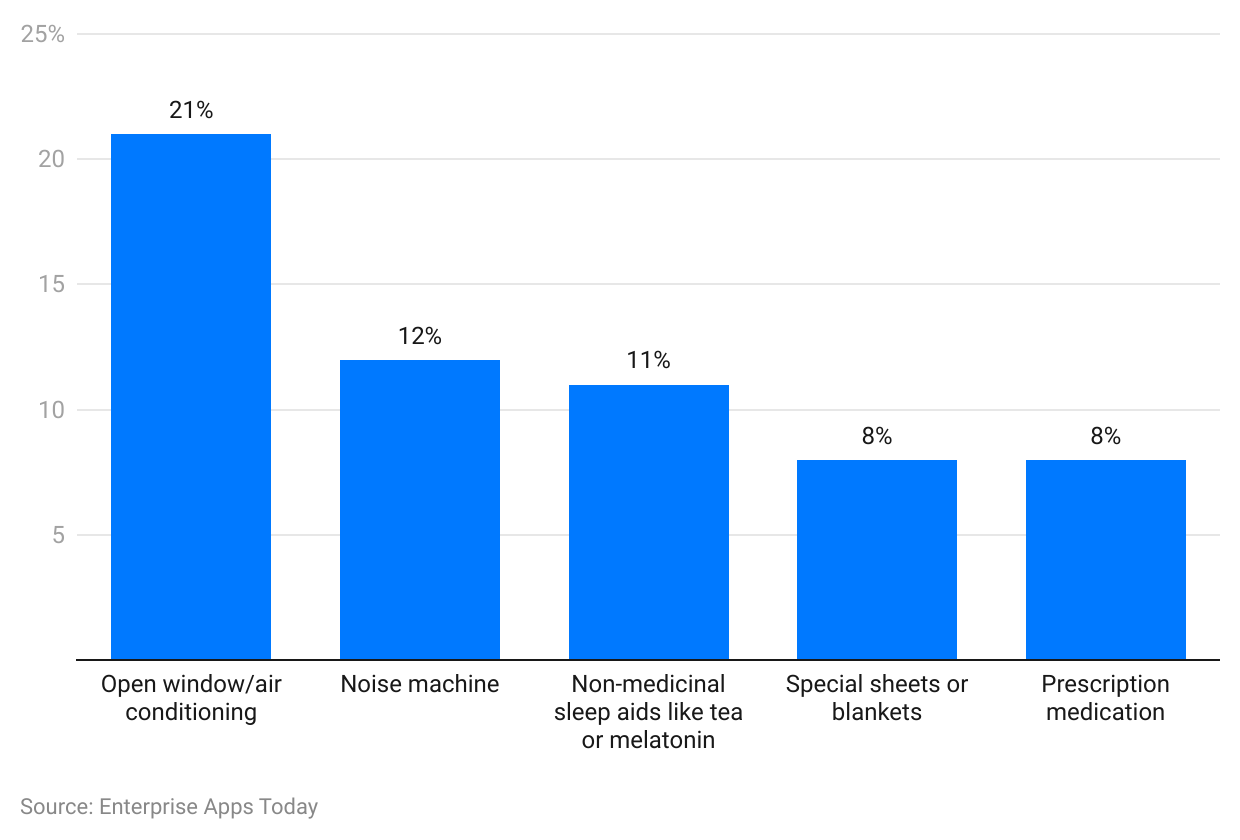
(Reference: Statista.com)
- According to Sleep Statistics of 2022, 21% of Americans open windows or turn on air conditioning as a sleep aid.
- 12% of the people in America use noise cancellation machines, while 11% of Americans with sleeping problems use non-medicinal sleep aids such as melatonin or tea.
- 8% of Americans changed their regular sheets to blankets or special sheets.
- On the other hand, 8% of people use prescription medications as a sleeping aid.
Conclusion
As adults, we wish to sleep more every second. We are so caught up with our plans that we have forgotten to add a Good Night's Sleep to our schedules. This is why people today are unhealthy and struggling with major health issues. People with stress issues must benefit themselves with regular sleep cycles to improve their mental health. Looking at these Sleep Statistics, we can certainly say that in every corner of the world, people have similar sleep problems irrespective of country, class, or education. Just try one week to follow a sleep cycle and see the magic happening around you.
Sources
FAQ.
One of the most common signs of sleep deprivation is being excessively tired. In addition to having difficulty concentrating, problem-solving, speaking, learning, or focusing, making silly mistakes, major behavioral changes in children, mood swings in adults, frequent dozing off during reading, working, or driving, or simply just being a potato couch.
Initially, it is difficult to make changes in your schedules which have been there for ages, adding a regular sleep cycle is not impossible. Make a to-do list, and allot time for each activity, this way you can sort out your priorities and give some time to yourself. This way, slowly you can improve your sleeping schedule.
If you can’t fall asleep during the night, you should start doing Yoga and meditation. This will calm your mind and. Do more of deep breathing exercises, limit caffeine intake, don’t stare at the screen before sleep time, eat less during dinner time, and try to keep stress levels low. In short, you should follow sleep hygiene.
This situation is called Hypnic jerks and is normal Hypnic jerks occur to due the stress level your body is going through. Most commonly your mind is trying to sleep but your body is awake. In this case, you should do meditation before sleeping and reduce the stress level in day-to-day life.

By conducting scientific research, I write about illness, health and healthcare. As a professional medical writer, my experience includes creating feature articles for newsletters and websites as well as research news stories for doctors and researchers. Reading has been an integral part of me since childhood - I'm fan of "Friends" and the "Harry Potter series". Before this career, I was employed by a French multinational company. However, my passion for reading led me to pursue writing professionally; my first Amazon-published short story entitled "The envelope that changed our lives" has recently been released. In my free moments, I enjoy long bike rides around town.